Lamb Wave-Based Structural Damage Detection: A Time Series Approach Using Cointegration
Abstract
:1. Introduction
2. A Brief Introduction of Cointegration Theory
3. Lamb Wave-Based Structural Damage Detection Based on Cointegration Analysis of Lamb Wave Series
3.1. Lamb Wave Experiments under the Effect of Temperature Variations
3.2. Composition of Lamb Wave Series Sharing Common Trends
3.3. Cointegration-Based Computation Procedure for the Analysis of Lamb Wave Series
4. Results and Discussion
4.1. The Case of Lamb Wave Series Exhibiting a Common Upward Trend of Temperature
4.2. The Case of Lamb Wave Series Exhibiting a Common Downward Trend of Temperature
4.3. Discussion
5. Conclusions
- The cointegration process could efficiently remove the influence of temperature trends. As a result, the damage can be detected by means of the direct observation of the shapes of the cointegration residuals without any computation.
- It is possible to distinguish the severities of damage by comparing the peak-to-peak amplitude and variance of the cointegration residuals.
- Through the idea of creating the time series of Lamb waves in the form that they exhibit some common trends, we have suggested a new way in applying the cointegration technique for SHM applications.
- The proposed approach is simple and more suitable for practical applications of Lamb wave-based methods because only cointegration is required, without the need for other data analysis techniques.
- Since each Lamb wave series includes a common upward (or downward) trend of temperature which involves multiple levels of temperature, the cointegration process can remove multi-temperature effects, rather than only one temperature when cointegration is applied to directly analyse Lamb wave responses measured at a certain temperature.
Funding
Institutional Review Board Statement
Informed Consent Statement
Data Availability Statement
Acknowledgments
Conflicts of Interest
References
- Farrar, C.R.; Worden, K. An introduction to structural health monitoring. Phil. Trans. R. Soc. A 2007, 365, 303–315. [Google Scholar] [CrossRef]
- Cawley, P. Structural health monitoring: Closing the gap between research and industrial deployment. Struct. Health Monit. 2018, 17, 1225–1244. [Google Scholar] [CrossRef]
- Kessler, S.S.; Spearing, S.M.; Soutis, C. Damage detection in composite materials using Lamb wave methods. Smart Mater. Struct. 2002, 11, 269–278. [Google Scholar] [CrossRef]
- Raghavan, A.; Carlos, C.E.S. Review of guided-wave structural health monitoring. Shock Vib. Dig. 2007, 39, 91–114. [Google Scholar] [CrossRef]
- Dao, P.B.; Staszewski, W.J. Cointegration approach for temperature effect compensation in Lamb wave based damage detection. Smart Mater. Struct. 2013, 22, 095002. [Google Scholar] [CrossRef]
- Liu, G.; Xiao, Y.; Zhang, H.; Ren, G. Baseline signal reconstruction for temperature compensation in Lamb wave-based damage detection. Sensors 2016, 16, 1273. [Google Scholar] [CrossRef] [PubMed]
- Salmanpour, M.S.; Sharif Khodaei, Z.; Aliabadi, M.H. Guided wave temperature correction methods in structural health monitoring. J. Intell. Mater. Syst. Struct. 2017, 28, 604–618. [Google Scholar] [CrossRef]
- Lee, S.E.; Hong, J.W. Detection of micro-cracks in metals using modulation of PZT-induced Lamb waves. Materials 2020, 13, 3823. [Google Scholar] [CrossRef]
- Zima, B.; Kędra, R. Numerical study of concrete mesostructure effect on Lamb wave propagation. Materials 2020, 13, 2570. [Google Scholar] [CrossRef]
- Zielińska, M.; Rucka, M. Imaging of increasing damage in steel plates using Lamb waves and ultrasound computed tomography. Materials 2021, 14, 5114. [Google Scholar] [CrossRef]
- Stepinski, T. Novel instrument for inspecting rock bolt integrity using ultrasonic guided waves. Measurement 2021, 177, 109271. [Google Scholar] [CrossRef]
- Yin, Z.; Tie, Y.; Duan, Y.; Li, C. Optimization of nonlinear Lamb wave detection system parameters in CFRP laminates. Materials 2021, 14, 3186. [Google Scholar] [CrossRef] [PubMed]
- Asokkumar, A.; Jasiūnienė, E.; Raišutis, R.; Kažys, R.J. Comparison of ultrasonic non-contact air-coupled techniques for characterization of impact-type defects in pultruded GFRP composites. Materials 2021, 14, 1058. [Google Scholar] [CrossRef] [PubMed]
- Xu, C.; Wang, J.; Yin, S.; Deng, M. A focusing MUSIC algorithm for baseline-free Lamb wave damage localization. Mech. Syst. Signal Process. 2022, 164, 108242. [Google Scholar] [CrossRef]
- Liu, X.; Yu, Y.; Lomov, S.V.; Wang, Y.; Qing, X. The numerical and experimental investigations for the curing monitoring of woven composites with Lamb waves. Measurement 2022, 200, 111604. [Google Scholar] [CrossRef]
- Sharma, B.N.; Kapuria, S.; Arockiarajan, A.; Kannusamy, M. Baseline-free damage detection and sizing under varying temperatures using Lamb waves without temperature compensation. Struct. Health Monit. 2023, 22, 3534–3557. [Google Scholar] [CrossRef]
- Mariani, S.; Heinlein, S.; Cawley, P. Location specific temperature compensation of guided wave signals in structural health monitoring. IEEE Trans. Ultrason. Ferroelectr. Freq. Control 2020, 67, 146–157. [Google Scholar] [CrossRef]
- Gorgin, R.; Luo, Y.; Wu, Z. Environmental and operational conditions effects on Lamb wave based structural health monitoring systems: A review. Ultrasonics 2020, 105, 106114. [Google Scholar] [CrossRef]
- Lee, B.C.; Staszewski, W.J. Lamb wave propagation modelling for damage detection: I. Two-dimensional analysis. Smart Mater. Struct. 2007, 16, 249–259. [Google Scholar] [CrossRef]
- Li, F.; Meng, G.; Ye, L.; Lu, Y.; Kageyama, K. Dispersion analysis of Lamb waves and damage detection for aluminum structures using ridge in the time-scale domain. Meas. Sci. Technol. 2009, 20, 095704. [Google Scholar] [CrossRef]
- Mitra, M.; Gopalakrishnan, S. Guided wave based structural health monitoring: A review. Smart Mater. Struct. 2016, 25, 053001. [Google Scholar] [CrossRef]
- Dao, P.B.; Staszewski, W.J. Lamb wave based structural damage detection using stationarity tests. Materials 2021, 14, 6823. [Google Scholar] [CrossRef] [PubMed]
- Engle, R.F.; Granger, C.W.J. Cointegration and error-correction: Representation, estimation and testing. Econometrica 1987, 55, 251–276. [Google Scholar] [CrossRef]
- Johansen, S. Statistical analysis of cointegration vectors. J. Econ. Dyn. Control 1988, 12, 231–254. [Google Scholar] [CrossRef]
- Cross, E.J.; Worden, K.; Chen, Q. Cointegration: A novel approach for the removal of environmental trends in structural health monitoring data. Proc. R. Soc. A 2011, 467, 2712–2732. [Google Scholar] [CrossRef]
- Dao, P.B. Cointegration method for temperature effect removal in damage detection based on Lamb waves. Diagnostyka 2013, 14, 61–67. [Google Scholar]
- Zhou, C.; Li, H.-N.; Li, D.-S.; Lin, Y.-X.; Yi, T.-H. Online damage detection using pair cointegration method of time-varying displacement. Smart Struct. Syst. 2013, 12, 309–325. [Google Scholar] [CrossRef]
- Comanducci, G.; Magalhães, F.; Ubertini, F.; Cunha, Á. On vibration-based damage detection by multivariate statistical techniques: Application to a long-span arch bridge. Struct. Health Monit. 2016, 15, 505–524. [Google Scholar] [CrossRef]
- Tabrizi, A.A.; Al-Bugharbee, H.; Trendafilova, I.; Garibaldi, L. A cointegration-based monitoring method for rolling bearings working in time-varying operational conditions. Meccanica 2017, 52, 1201–1217. [Google Scholar] [CrossRef]
- Michalak, A.; Wodecki, J.; Wyłomańska, A.; Zimroz, R. Application of cointegration to vibration signal for local damage detection in gearboxes. Appl. Acoust. 2019, 144, 4–10. [Google Scholar] [CrossRef]
- Dao, P.B.; Staszewski, W.J.; Klepka, A. Stationarity-based approach for the selection of lag length in cointegration analysis used for structural damage detection. Comput. Aided Civ. Infrastruct. Eng. 2017, 32, 138–153. [Google Scholar] [CrossRef]
- Huang, J.; Li, D.; Li, H.; Song, G.; Liang, Y. Damage identification of a large cable-stayed bridge with novel cointegrated Kalman filter method under changing environments. Struct. Control Health Monit. 2018, 25, e2152. [Google Scholar] [CrossRef]
- Coletta, G.; Miraglia, G.; Pecorelli, M.; Ceravolo, R.; Cross, E.J.; Surace, C.; Worden, K. Use of the cointegration strategies to remove environmental effects from data acquired on historical buildings. Eng. Struct. 2019, 183, 1014–1026. [Google Scholar] [CrossRef]
- Salvetti, M.; Sbarufatti, C.; Cross, E.J.; Corbetta, M.; Worden, K.; Giglio, M. On the performance of a cointegration-based approach for novelty detection in realistic fatigue crack growth scenarios. Mech. Syst. Signal Process. 2019, 123, 84–101. [Google Scholar] [CrossRef]
- He, H.; Wang, W.; Zhang, X. Frequency modification of continuous beam bridge based on co-integration analysis considering the effect of temperature and humidity. Struct. Health Monit. 2019, 18, 376–389. [Google Scholar] [CrossRef]
- Tomé, E.S.; Pimentel, M.; Figueiras, J. Damage detection under environmental and operational effects using cointegration analysis—Application to experimental data from a cable-stayed bridge. Mech. Syst. Signal Process. 2020, 135, 106386. [Google Scholar] [CrossRef]
- Turrisi, S.; Cigada, A.; Zappa, E. A cointegration-based approach for automatic anomalies detection in large-scale structures. Mech. Syst. Signal Process. 2022, 166, 108483. [Google Scholar] [CrossRef]
- Dao, P.B.; Staszewski, W.J.; Uhl, T. Operational condition monitoring of wind turbines using cointegration method. In Advances in Condition Monitoring of Machinery in Non-Stationary Operations, Applied Condition Monitoring; Timofiejczuk, A., Chaari, F., Zimroz, R., Bartelmus, W., Haddar, M., Eds.; Springer: Cham, Switzerland, 2018; Volume 9, Chapter 21; pp. 223–233. [Google Scholar]
- Dao, P.B. Condition monitoring of wind turbines based on cointegration analysis of gearbox and generator temperature data. Diagnostyka 2018, 19, 63–71. [Google Scholar] [CrossRef]
- Qadri, B.A.; Ulriksen, M.D.; Damkilde, L.; Tcherniak, D. Cointegration for detecting structural blade damage in an operating wind turbine: An experimental study. In Dynamics of Civil Structures, Conference Proceedings of the Society for Experimental Mechanics Series; Pakzad, S., Ed.; Springer: Cham, Switzerland, 2020; Volume 2, pp. 173–180. [Google Scholar]
- Li, G.; Qin, S.J.; Yuan, T. Nonstationarity and cointegration tests for fault detection of dynamic processes. In Proceedings of the 19th IFAC World Congress, Cape Town, South Africa, 24–29 August 2014; Volume 47, pp. 10616–10621. [Google Scholar]
- Xu, M.; Li, J.; Wang, S.; Yang, N.; Hao, H. Damage detection of wind turbine blades by Bayesian multivariate cointegration. Ocean Eng. 2022, 258, 111603. [Google Scholar] [CrossRef]
- Dao, P.B.; Staszewski, W.J. Cointegration and how it works for structural health monitoring. Measurement 2023, 209, 112503. [Google Scholar] [CrossRef]
- Dickey, D.A.; Fuller, W.A. Likelihood ratio statistics for autoregressive time series with a unit root. Econometrica 1981, 49, 1057–1072. [Google Scholar] [CrossRef]
- Zivot, E.; Wang, J. Modeling Financial Time Series with S-PLUS, 2nd ed.; Springer: New York, NY, USA, 2006. [Google Scholar]
- The MathWorks Inc. Econometrics ToolboxTM, Release 2019b; The MathWorks Inc.: Natick, MA, USA, 2019. [Google Scholar]
- Lee, B.C.; Manson, G.; Staszewski, W.J. Environmental effects on lamb wave responses from piezoceramic sensors. Mater. Sci. Forum 2003, 440–441, 195–202. [Google Scholar] [CrossRef]
- Zhang, Y.; Abraham, O.; Tournat, V.; Le Duff, A.; Lascoup, B.; Loukili, A.; Grondin, F.; Durand, O. Validation of a thermal bias control technique for Coda Wave Interferometry (CWI). Ultrasonics 2013, 53, 658–664. [Google Scholar] [CrossRef]
- Shan, S.; Liu, Z.; Cheng, L.; Pan, Y. Metamaterial-enhanced coda wave interferometry with customized artificial frequency-space boundaries for the detection of weak structural damage. Mech. Syst. Signal Process. 2022, 174, 109131. [Google Scholar] [CrossRef]
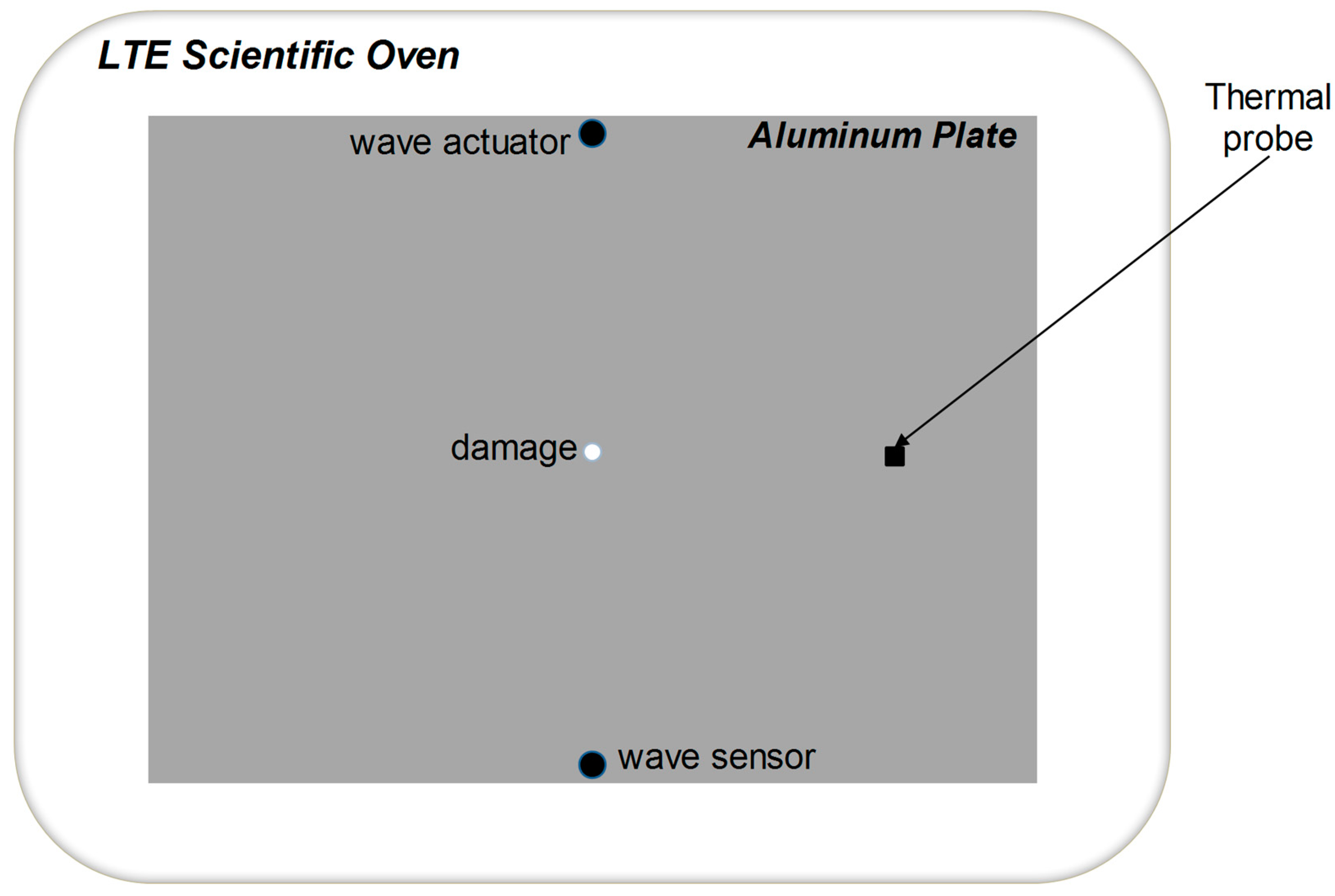

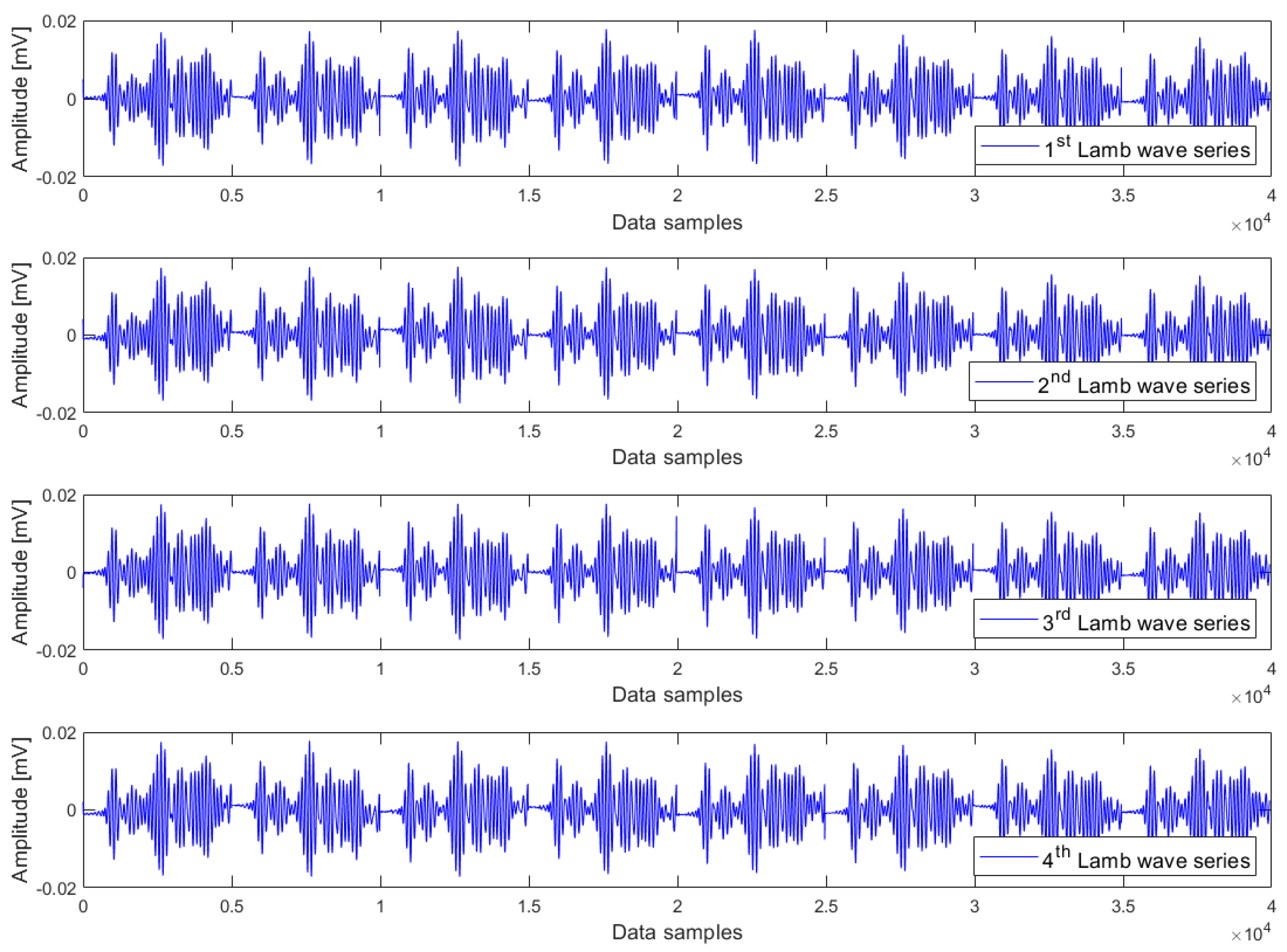
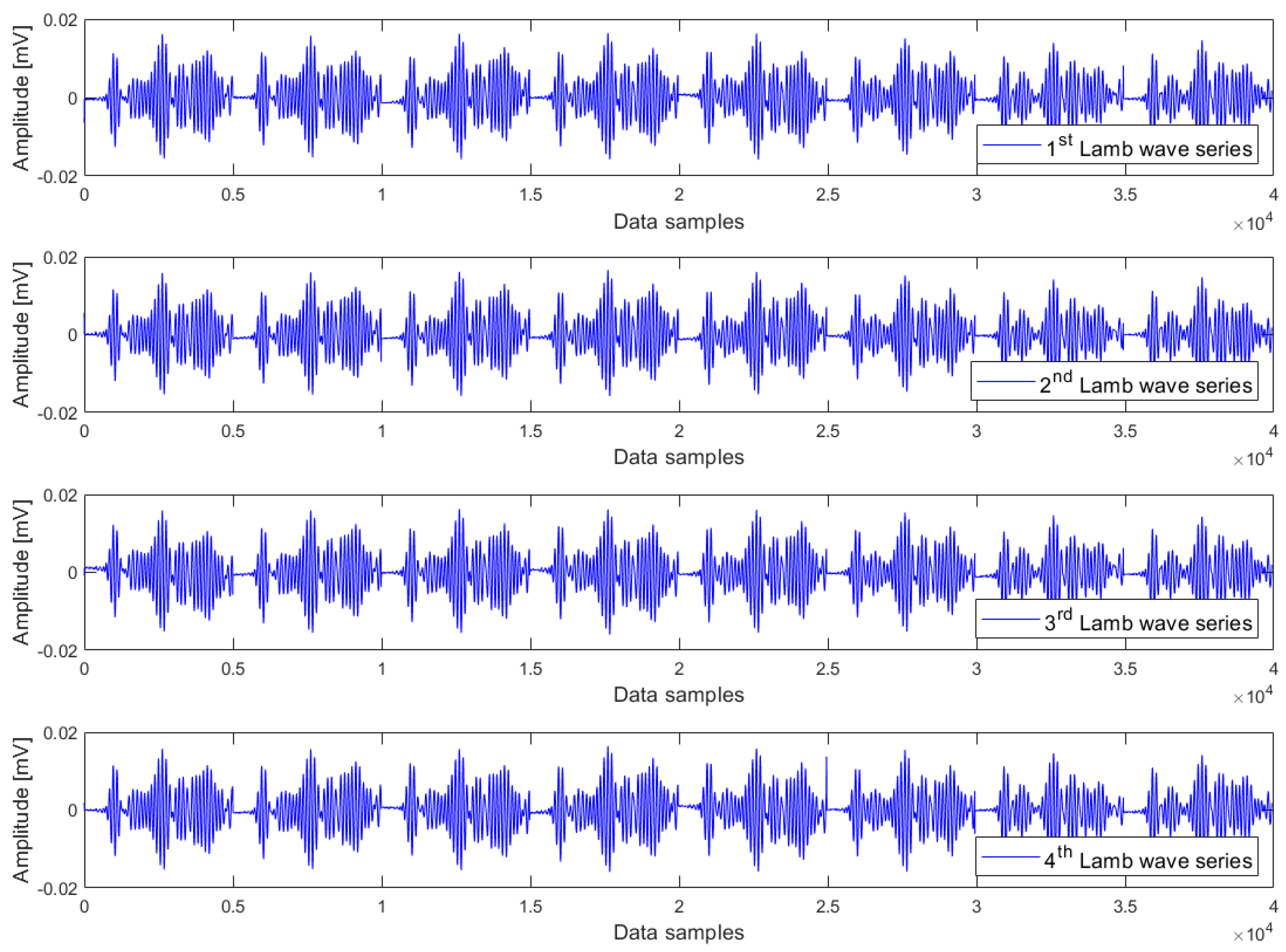


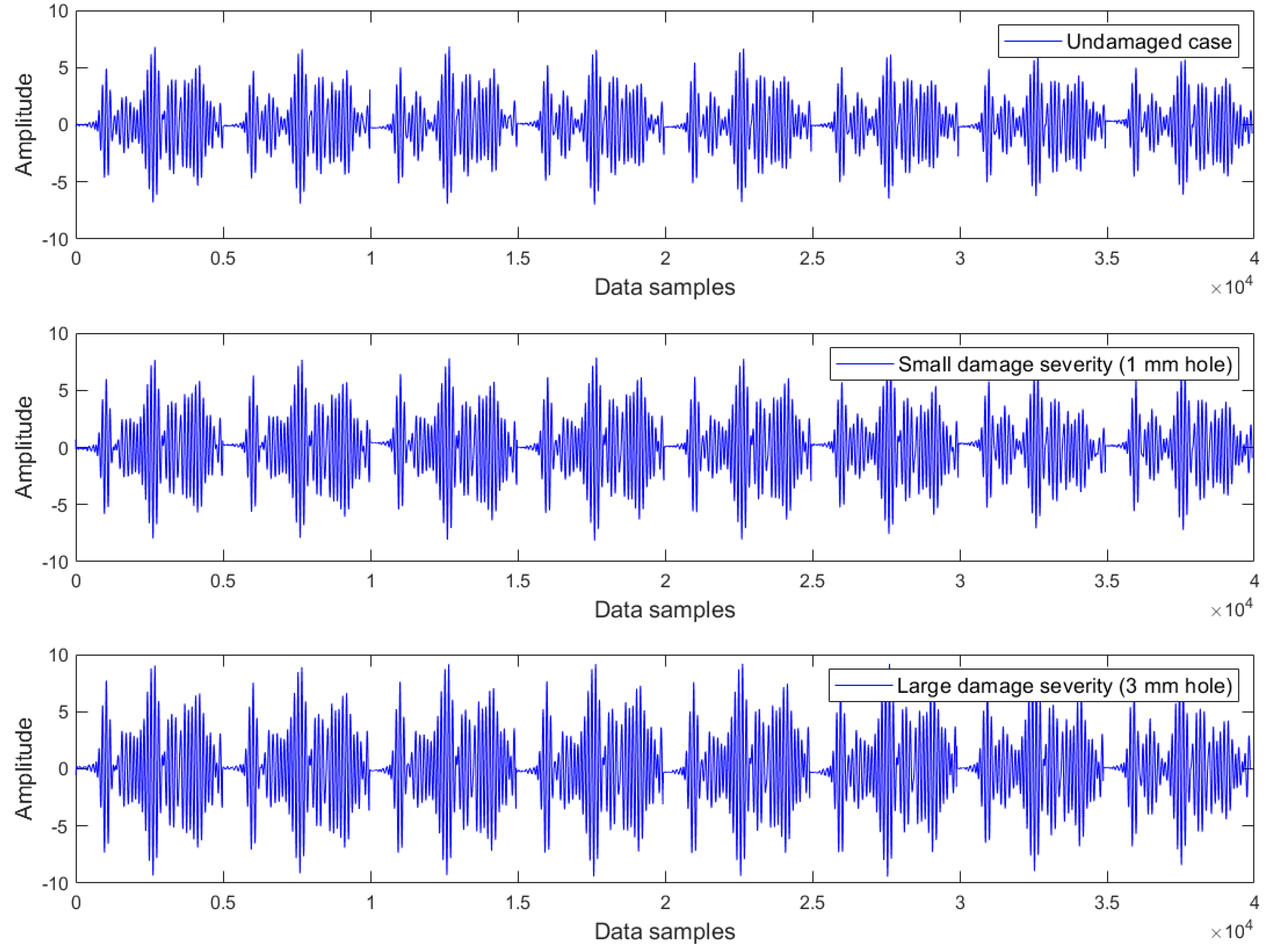
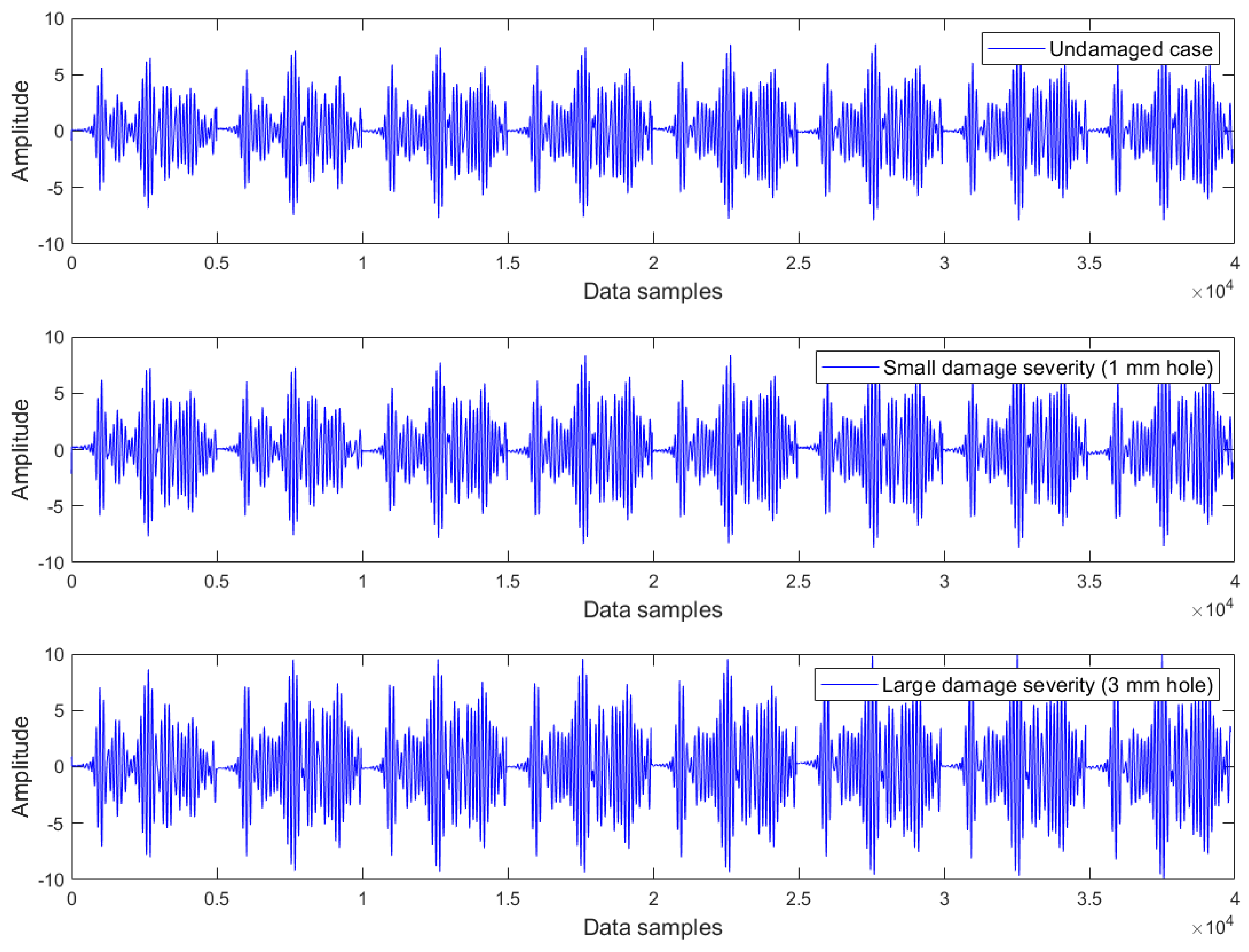
| Damage Conditions | Peak-to-Peak Amplitude | Variance |
|---|---|---|
| Undamaged case | 13.84 | 4.37 |
| Small damage severity (1 mm hole) | 16.02 | 6.23 |
| Large damage severity (3 mm hole) | 18.62 | 9.25 |
| Damage Conditions | Peak-to-Peak Amplitude | Variance |
|---|---|---|
| Undamaged case | 15.64 | 6.02 |
| Small damage severity (1 mm hole) | 17.32 | 7.22 |
| Large damage severity (3 mm hole) | 20.06 | 10.23 |
Disclaimer/Publisher’s Note: The statements, opinions and data contained in all publications are solely those of the individual author(s) and contributor(s) and not of MDPI and/or the editor(s). MDPI and/or the editor(s) disclaim responsibility for any injury to people or property resulting from any ideas, methods, instructions or products referred to in the content. |
© 2023 by the author. Licensee MDPI, Basel, Switzerland. This article is an open access article distributed under the terms and conditions of the Creative Commons Attribution (CC BY) license (https://creativecommons.org/licenses/by/4.0/).
Share and Cite
Dao, P.B. Lamb Wave-Based Structural Damage Detection: A Time Series Approach Using Cointegration. Materials 2023, 16, 6894. https://doi.org/10.3390/ma16216894
Dao PB. Lamb Wave-Based Structural Damage Detection: A Time Series Approach Using Cointegration. Materials. 2023; 16(21):6894. https://doi.org/10.3390/ma16216894
Chicago/Turabian StyleDao, Phong B. 2023. "Lamb Wave-Based Structural Damage Detection: A Time Series Approach Using Cointegration" Materials 16, no. 21: 6894. https://doi.org/10.3390/ma16216894
APA StyleDao, P. B. (2023). Lamb Wave-Based Structural Damage Detection: A Time Series Approach Using Cointegration. Materials, 16(21), 6894. https://doi.org/10.3390/ma16216894






